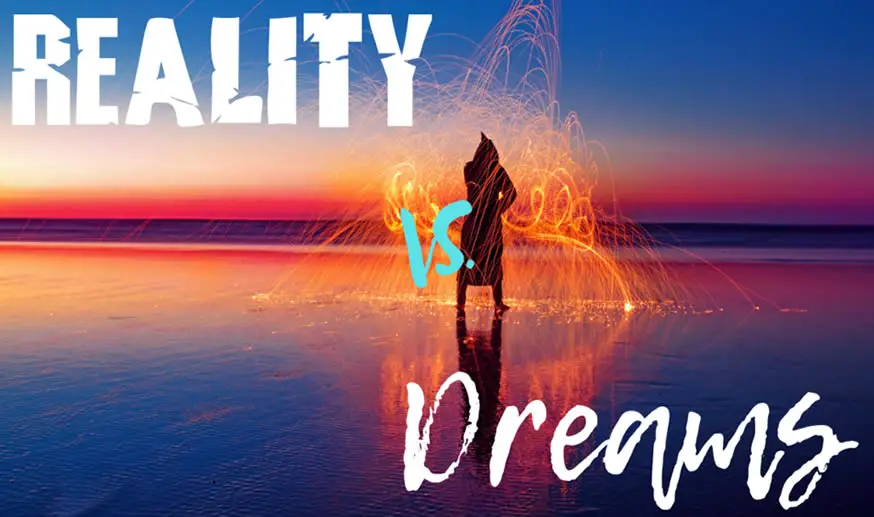
Lucid dreaming can be a lot of fun as you have the ability to live out your fantasies and do things you could never do in the real world. Additionally, you can also use your lucid dreams to relive memories and even to perfect real world skills. These things are all possible because lucid dreaming feels like real life. But why do lucid dreams feel real?
Lucid dreams feel real because areas of your brain that are usually only active during your waking state are activated during the dream state.
Research has shown that key brain areas associated with higher cognitive functions, attention, working memory, planning, and self-consciousness are active during a lucid dream thus helping to make the dreamworld feel real.
Contents
Real world dreams
Although there are some people who claim their lucid dreams do not feel real, authentic lucid dreams are very life-like and feel just as real as the waking world.
People who experience hazy lucid dreams are actually not fully consciously-aware during the dream state and are only have vivid dreams, not actual controlled lucid dreams.
Lucid dreams are very life-like.
The only difference between how you feeling and interact with things in a lucid dream and how you feel and interact with things in real-life, is that the laws of physics are suspended within a lucid dream.
A lucid dreamer also has full control over how a lucid dream unfolds.
A lucid dream can be best described as being a vivid life-like dream over which the dream has a high degree of control.
The difference between a vivid dream and a lucid dream lies in two key areas:
- Control over the dream.
- The dream feels just as real as the waking world.
To understand why a lucid dream feels real and not hazy like a normal dream I have to quickly rectify at least one major misunderstanding about lucid dreaming.
There is a statement that is often made about lucid dreaming which is popularly repeated in articles and videos related to this phenomenon.
This statement goes something like, “a lucid dreamer has complete control over the dream”.
Contrary to popular opinion a lucid dreamer does not have 100% conscious control over the dreamworld simply because they are not consciously responsible for its construction.
What do I mean by this?
Well, although a lucid dreamer does have full control over how a dream unfolds and the direction in which it goes he/she does not have full control over the dreamworld.
The lucid dreamer will have full control over how they interact with the dreamworld and over their own actions within it but they will rarely have control over other characters in the dreamworld unless they make a concerted effort to do so.
Neither will the lucid dreamer have full control over the construct/environmental factors within the dream.
Why doesn’t a lucid dreamer have full control over the lucid dreamworld? Because the lucid dreamer does not create that dreamworld.
The subconscious mind does that.
Although a lucid dreamer can “will” or “intend” a dream to take a certain shape, direction or follow a specific set of parameters it is the subconscious mind that creates the dream and everything in it.
You may “will” a 17th Century tavern to appear, filled with characters, but you cannot consciously construct that inn or those characters. Your conscious mind just does not have access to that type of processing power and you simply don’t consciously know how to do it either!
Think of a lucid dream as a stage show or movie and the conscious mind as the director.
The subconscious mind creates the stage along with all the scenes, characters and everything else in the dreamworld while the lucid dreamer directs the play.
Now, this is all very interesting but what does it have to do with our initial question “why do lucid dreams feel real?” … bear with me, it’s all connected.
The mental causes for life-like dreams
In scientific research carried out into the brain, researchers found that the brain cannot tell the difference between an imagined event and a real one.
As Dr. David Hamilton PhD points out, scans show that the brain reacts in the same manner whether an event is real or simply imagined.
This research backs-up the belief held by many hypnosis experts and teachers of visualization who claim that the subconscious mind cannot differentiate between an imagined event and a real one.
They state that imagining an event over and over again forms neural networks within the brain that help you to perform better in the real world.
Like visualizing striking the ball perfectly for a home run or executing the prefect field goal can make it easier to achieve those things in real life.
If you think visualization cannot help you achieve better results in real life then maybe you should take that up with NASA who train their astronauts to do it and the Olympic athletes who use it to improve their performances.
They use a technique called Visual Motor Behavior Rehearsal, which compromises of them visualizing themselves successfully completing a task, such as winning a race.
Are you starting to see the connection now between the feeling of a lucid dream and the feeling of the real real-world?
As the subconscious part of the brain is in control of creating the dreamworld, and because the brain cannot tell the difference between what is real and what is imagined, a dreamworld is created that feels just as real as real life.
I will cover more why it feels real later after we look at the brain functions associated with life-like lucid dreaming.
Now that we have a better understanding of the mental reasons for vivid life-like dreaming (and you will understand more as we progress) we can delve deeper and look at the physical causes behind lucid dreaming as they occur in the brain.
The brain functions that are responsible for lucid dreams
Although scientists still do not fully understand the exact nature of dreams, and which specific brain functions are related to dreaming, we do know much more now than we ever have before about brain states in sleep and dreams.
And, with access to modern 21st Century technology we can now look at the brain to see what is happening during sleep, during normal dreams and during lucid dreams.
When we look at what is actually happening in the brain during a lucid dream and compare it with what is happening in a normal dream we can better understand why lucid dreams occur in the first place and why they feel so real.
In their research paper, Exploring the neural correlates of dream phenomenology and altered states of consciousness during sleep, researchers Julian Mutz and Amir-Homayoun Javadi demonstrate how they found that lucid dreaming is actually a hybrid state of consciousness.
They found that this consciousness state incorporates both aspects of waking consciousness and dream consciousness.
During their research Mutz and Javadi studied multiple scientific studies that had looked at brain activity which occurred during sleep.
They also paid close attention to data collected by previous researchers that focused on the difference between brain activity in a regular dream and brain activity in a lucid dream.
What did they discover?
Mutz and Javid realized that during lucid dreaming the brain activity was markedly different that it was during normal dreaming.
Areas of the brain which are normally subdued during the dream state, and that are associated with waking activities such as higher cognitive functions, focus/attention, working memory, planning and self-consciousnesses, are actual active during lucid dreaming.
Areas of the brain that are normally not active during sleep and normal dreams are active in lucid dreaming.
These areas are the dorsolateral prefrontal cortex, the bilateral frontopolar prefrontal cortex, the precuneus, the inferior parietal lobules, and the supramarginal gyrus.
What does this mean?
Well, it means that parts of the brain that we use to navigate the waking world, which experience greatly reduced activity during normal sleep, are functioning at a much higher capacity during a lucid dream.
This activity causes the dreamer to become totally aware that they are dreaming and gives them full control over their own actions and reactions during the dream state.
The brain effectively wakes up the conscious mind in a lucid dream.
How these combined brain activities lead to life-like lucid dreams
Because the brain wakes up the conscious mind within a lucid dream it should be obvious why a lucid dreamer becomes aware that they are dreaming.
It should also be fairly evident why they also have full control over their actions within the dream – they are in a similar mental state in the lucid dream that they are normally in while in the waking state.
Thus the lucid dreamer has full control over their own actions being able to decide what they are going to do, or not do, just as they would in the waking world.
Of course this only accounts for the phenomenon of conscious awareness with the lucid dream and this is only half of the story.
What about the life-like nature of the dream itself?
Well, as we have discovered, the brain and specifically the subconscious mind, cannot tell the difference between a real event, a real place, or a real scenario and an imagined one.
Because the brain/subconscious mind is responsible for creating the dreamworld, the lucid dreamer finds that they merely become consciously aware in a world that feels real.
Remember, everything we experience, we experience in our minds. Even this post is happening in your mind as your eyes registers the screen and the words on it and send that light to your brain to decode and decipher.
Even when you smell freshly cut grass or fragrant flowers in the waking world those sensations are happening in your brain.
It is simply your brain decoding information.
So … when you lucid dream a part of your brain recreates the same sensations from the real world to create an imagined dreamworld.
As the brain cannot tell the difference between what is real and what is imagined your conscious mind therefore feels the dream as though it were real.
This is why you can enjoy your deepest fantasies as though they were real in a lucid dream and even perfect physical skills by practicing them while lucid dreaming.
In fact, it has been shown that lucid dreaming can affect reality in some very surprising ways.
Hopefully, this post was not too technical and helped you to understand why lucid dreams feel so real and life-like.
If you are ready to try lucid dreaming for yourself be sure to follow our simple steps to achieve your first lucid dream which we offer for free.
If you are already a regular lucid dreamer and want to take your skills to the next level check out these advanced lucid dreaming techniques for getting more from your lucid dreams, for having more of them and for prolonging them.
